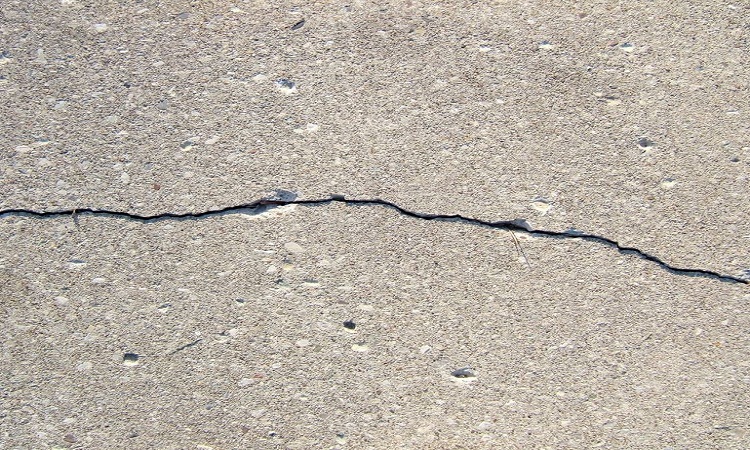Cracks in the concrete basement floor can be a reason for panic for homeowners. Most concrete basement floor cracks are normal and do not need to be repaired. However, some cracks in the concrete basement floor can let in water, moisture, and dangerous soil gasses.
Is It Normal For Concrete Basement Floors To Cracks?
Cracking is a natural occurrence in concrete. When concrete first poured, it is in a liquid state. Over a couple of days, it will start to harden into a solid concrete slab, slowly shrinking as it does. As the concrete shrinks, it will gradually start to form hairline cracks. Hairline cracks are normal and don’t influence the integrity of the concrete.
Often contractors might add a little too much water to the concrete mix to make it simpler for them, to apply. This also makes the concrete more prone to cracking & not uncommon for it to crack even one year after the initial construction.
Changing temperatures could also play a toll on concrete & cause thin cracks to appear over time. The best thing to do is to keep an eye on the cracks and check whether they are deteriorating.
What Causes Cracks in Concrete Basement Floors?
Cracks with heaving are signs of a bigger issue that requires addressing.
At the point when a concrete basement floor crack is combined with heaving, this is a reason for concern. Heaving recommends that the soil underneath the concrete basement floor is enlarging. Heaving is particularly common in regions with clay soil. At the point when the soil gets wet, it makes sufficient pressure to lift and crack a concrete slab floor.
Solution: Call a professional foundation repair contractor. They can assess the circumstance and suggest the best solution.
Concrete basement floors with cracks & sinking should be leveled.
At the point when a foundation settles, the concrete slab can crack & the slab part that is less supported sinks into the depression. The occurring uneven surface can create a tripping hazard.
Solution: concrete basement floors that are uneven or not in level should be leveled. Polylevel utilizes a high-density polyurethane formula for all-time lift & stabilize a sinking concrete slab. Penny-sized openings are drilled into the slab & a structural-grade polymer is injected into the void. The polyurethane material expands, lifting & leveling the slab.
The gap between the basement wall and floor should not be sealed.
The area in the basement where the walls and floor meet called the cove joint is a common problem area for water seepage. When the concrete walls and floor have pored during construction, a small gap is left between the floors and walls. When the groundwater table rises & the soil becomes soaked, hydrostatic pressure forces water through the cove joint.
Solution: A sealing of the gap is not recommended since the sealant can crack. The most effective solution to keep and moisture out of the cove joint is with a basement waterproofing system, which helps relieve hydrostatic pressure.
Hairline Cracks Don’t Require Repair
Hairline cracks in the concrete basement floor normally result from shrinkage as the concrete dries, which pulls the concrete apart. These all kinds of cracks can show up to a year after the basement floor is poured, depending on how speedily the slab dries and how moist or humid the basement is.
Solution: Nothing. Hairline cracks is the basement floor are superficial and don’t require repair.

1/8-Inch or Wider Cracks should be Sealed.
Like hairline cracks, these slightly wider cracks are likely the result of shrinkage and aren’t an indication of a serious foundation issue. Notwithstanding, even little cracks in the concrete basement floor can allow water, moisture/dampness, and radon to enter the basement.
Solution: Cracks wider than 1/8-inch should be sealed to help keep water, moisture or dampness, soil smells, and radon gas from seeping through the basement floor.
Spalling or Flaking is Ugly but Does Not Require Repair
It can occur when the concrete mix is too wet or has not been properly cured. The water evaporates from the exposed surface of concrete and loosens the top layer of the concrete, causing it to flake off. Concrete spalling or flaking is unattractive, but chances are the slab is still in good shape.
Solution: Don’t try to hide the problem with paint. The surface of the floor is probably to keep flaking & when it does, it will take the paint off as well. Consider concrete resurfacing to make the concrete look new & prevent future spalling. Another alternative is to install waterproof flooring over the concrete.
Risks of Cracks in Concrete Basement Floors
Water Seepage
Any cracks in the concrete basement floor open to the possibility of water seepage. The ground underneath the foundation is full of moisture. When there are cracks in the home’s foundation, it lets pressure force the water up into the basement.
Structural Problems
The concrete basement floor will always crack. Fortunately, these all small cracks like those from shrinkage, rarely or hardly impact the structural integrity of the home. Though, bigger cracks or those caused by instability of the soil underneath the house can lead to major issues. If we notice critical cracks in the concrete basement floor, make sure to have them inspected or reviewed by an expert to identify their damage potential.
Invasive Pests
There are plenty of pests that consider a crack in the foundation to be an open invitation to home. While all things considered, you would fix a crack in a wall anywhere else in your home. It’s not uncommon for cracks in the basement floor or walls to go unnoticed. Even if you don’t frequently use the basement. Moreover to the other potential damage caused by cracks, this is a valid reason to sort them out at the earliest- otherwise, you might be sharing your home with all sorts of critters.






